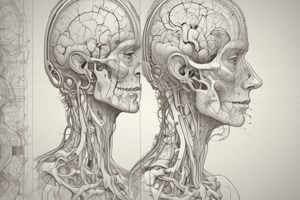Podcast
Questions and Answers
Which movement disorder is characterized by high amplitude flailing of the limbs on one side of the body?
Which movement disorder is characterized by high amplitude flailing of the limbs on one side of the body?
- Tics
- Hyperkinesis
- Ballismus (correct)
- Chorea
What is the pathophysiology of hemiballismus?
What is the pathophysiology of hemiballismus?
- Direct pathway
- Excitatory cortex pathway
- Inhibitory striatum pathway
- Indirect pathway (correct)
What is the most common cause of hemiballismus?
What is the most common cause of hemiballismus?
- Chorea
- Parkinson's disease
- Stroke (correct)
- Tourette's syndrome
Which movement disorder is characterized by brief repetitive stereotyped movements with a premonitory urge?
Which movement disorder is characterized by brief repetitive stereotyped movements with a premonitory urge?
Which type of tic disorder is characterized by motor disorder and rare coprolalia (swearing)?
Which type of tic disorder is characterized by motor disorder and rare coprolalia (swearing)?
What can reduce tic disorders?
What can reduce tic disorders?
Which movement disorder is characterized by disturbance of coordination?
Which movement disorder is characterized by disturbance of coordination?
Which of the following is a symptom of Parkinson's disease?
Which of the following is a symptom of Parkinson's disease?
What is the primary neurodegenerative condition that affects dopaminergic cells of the substantia nigra?
What is the primary neurodegenerative condition that affects dopaminergic cells of the substantia nigra?
Which of the following is a treatment option for Tardive dyskinesia?
Which of the following is a treatment option for Tardive dyskinesia?
What is the main histopathological hallmark of Parkinson's disease?
What is the main histopathological hallmark of Parkinson's disease?
Which neurotransmitter is reduced in the basal ganglia in Parkinson's disease?
Which neurotransmitter is reduced in the basal ganglia in Parkinson's disease?
What is the primary role of monoamine oxidase inhibitors (MAO-I) in the treatment of Parkinson's disease?
What is the primary role of monoamine oxidase inhibitors (MAO-I) in the treatment of Parkinson's disease?
What is the gold standard treatment for Parkinson's disease?
What is the gold standard treatment for Parkinson's disease?
Which of the following is NOT a common co-morbid condition associated with Tourette syndrome?
Which of the following is NOT a common co-morbid condition associated with Tourette syndrome?
Which part of the brain is primarily affected in Tourette syndrome?
Which part of the brain is primarily affected in Tourette syndrome?
What is the genetic inheritance pattern of Huntington's disease?
What is the genetic inheritance pattern of Huntington's disease?
What is the main neurotransmitter imbalance thought to contribute to the development of dystonia?
What is the main neurotransmitter imbalance thought to contribute to the development of dystonia?
Which of the following movement disorders is characterized by involuntary, rhythmic, sinusoidal alternating movements?
Which of the following movement disorders is characterized by involuntary, rhythmic, sinusoidal alternating movements?
What is the proposed theory for the pathophysiology of essential tremor?
What is the proposed theory for the pathophysiology of essential tremor?
What type of drugs are commonly used to treat hyperkinetic movement disorders like tics, chorea, and ballismus?
What type of drugs are commonly used to treat hyperkinetic movement disorders like tics, chorea, and ballismus?
Which of the following is a pros of using COMT inhibitors with L-dopa?
Which of the following is a pros of using COMT inhibitors with L-dopa?
Which of the following is a cons of using COMT inhibitors with L-dopa?
Which of the following is a cons of using COMT inhibitors with L-dopa?
Which of the following is a clinical effect of Entacapone, a COMT inhibitor?
Which of the following is a clinical effect of Entacapone, a COMT inhibitor?
What is the clinical effect of Duodopa, a duodenal L-dopa infusion, for advanced Parkinson's disease?
What is the clinical effect of Duodopa, a duodenal L-dopa infusion, for advanced Parkinson's disease?
What is the main advantage of dopamine agonists over L-dopa?
What is the main advantage of dopamine agonists over L-dopa?
What is a potential side effect of Apomorphine, a dopamine agonist given by subcutaneous infusion?
What is a potential side effect of Apomorphine, a dopamine agonist given by subcutaneous infusion?
What is the favored target for deep brain stimulation in Parkinson's disease?
What is the favored target for deep brain stimulation in Parkinson's disease?
What is the effect of deep brain stimulation on disease progression in Parkinson's disease?
What is the effect of deep brain stimulation on disease progression in Parkinson's disease?
What are the future potential treatments for Parkinson's disease mentioned in the text?
What are the future potential treatments for Parkinson's disease mentioned in the text?
Which movement disorder is characterized by a tri nucleotide repeat on chromosome four?
Which movement disorder is characterized by a tri nucleotide repeat on chromosome four?
What is the mode of inheritance for Huntington's disease?
What is the mode of inheritance for Huntington's disease?
Which movement disorder is characterized by abnormal twisting postures, often axial?
Which movement disorder is characterized by abnormal twisting postures, often axial?
Which movement disorder is characterized by involuntary, rhythmic, sinusoidal alternating movements?
Which movement disorder is characterized by involuntary, rhythmic, sinusoidal alternating movements?
What is the primary treatment for hyperkinetic movement disorders?
What is the primary treatment for hyperkinetic movement disorders?
What is the mechanism behind tardive dyskinesia?
What is the mechanism behind tardive dyskinesia?
Which non-motor symptom is commonly associated with Parkinson's disease?
Which non-motor symptom is commonly associated with Parkinson's disease?
What is the key symptom required for a diagnosis of Parkinson's disease?
What is the key symptom required for a diagnosis of Parkinson's disease?
Which movement disorder is characterized by high amplitude flailing of the limbs on one side of the body?
Which movement disorder is characterized by high amplitude flailing of the limbs on one side of the body?
What is the primary role of dopamine in treating Parkinson's disease?
What is the primary role of dopamine in treating Parkinson's disease?
What is the main neurotransmitter imbalance thought to contribute to the development of dystonia?
What is the main neurotransmitter imbalance thought to contribute to the development of dystonia?
What is the proposed theory for the pathophysiology of essential tremor?
What is the proposed theory for the pathophysiology of essential tremor?
Which movement disorder is the focus of this lecture?
Which movement disorder is the focus of this lecture?
What is the role of the basal ganglia in movement disorders?
What is the role of the basal ganglia in movement disorders?
Which part of the brain is primarily affected in Parkinson's disease?
Which part of the brain is primarily affected in Parkinson's disease?
What are the other two lectures in this series about?
What are the other two lectures in this series about?
What is the main cause of abnormal postures in dystonia?
What is the main cause of abnormal postures in dystonia?
Which part of the brain is primarily affected in Parkinson's disease?
Which part of the brain is primarily affected in Parkinson's disease?
Which neurotransmitter is thought to be involved in the pathophysiology of essential tremor?
Which neurotransmitter is thought to be involved in the pathophysiology of essential tremor?
What is the most common movement disorder encountered in the gerontology clinic?
What is the most common movement disorder encountered in the gerontology clinic?
Which movement disorder is characterized by jerky, irregular contractions that appear fidgety and faceless?
Which movement disorder is characterized by jerky, irregular contractions that appear fidgety and faceless?
What is the common feature among all movement disorders that involve the basal ganglia?
What is the common feature among all movement disorders that involve the basal ganglia?
What is the primary neurotransmitter imbalance thought to contribute to the development of dystonia?
What is the primary neurotransmitter imbalance thought to contribute to the development of dystonia?
What is the main advantage of dopamine agonists over L-dopa in the treatment of Parkinson's disease?
What is the main advantage of dopamine agonists over L-dopa in the treatment of Parkinson's disease?
Which of the following is a common cause of Parkinsonism?
Which of the following is a common cause of Parkinsonism?
What is the primary neurotransmitter imbalance in Parkinson's disease?
What is the primary neurotransmitter imbalance in Parkinson's disease?
What is the effect of misfolded proteins on cellular processes?
What is the effect of misfolded proteins on cellular processes?
What is the main histopathological hallmark of Parkinson's disease?
What is the main histopathological hallmark of Parkinson's disease?
What is the term used to describe Parkinson-like symptoms that are not idiopathic Parkinson's disease?
What is the term used to describe Parkinson-like symptoms that are not idiopathic Parkinson's disease?
What is the most common cause of Parkinsonism?
What is the most common cause of Parkinsonism?
Flashcards are hidden until you start studying




